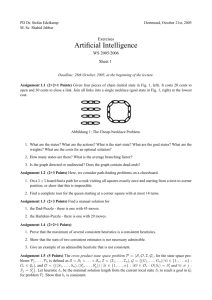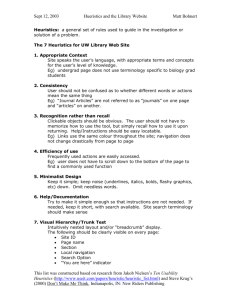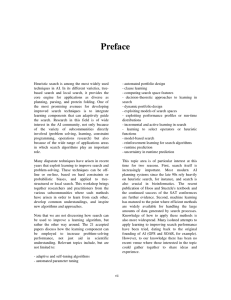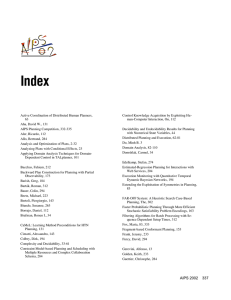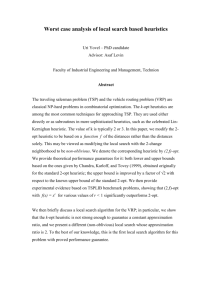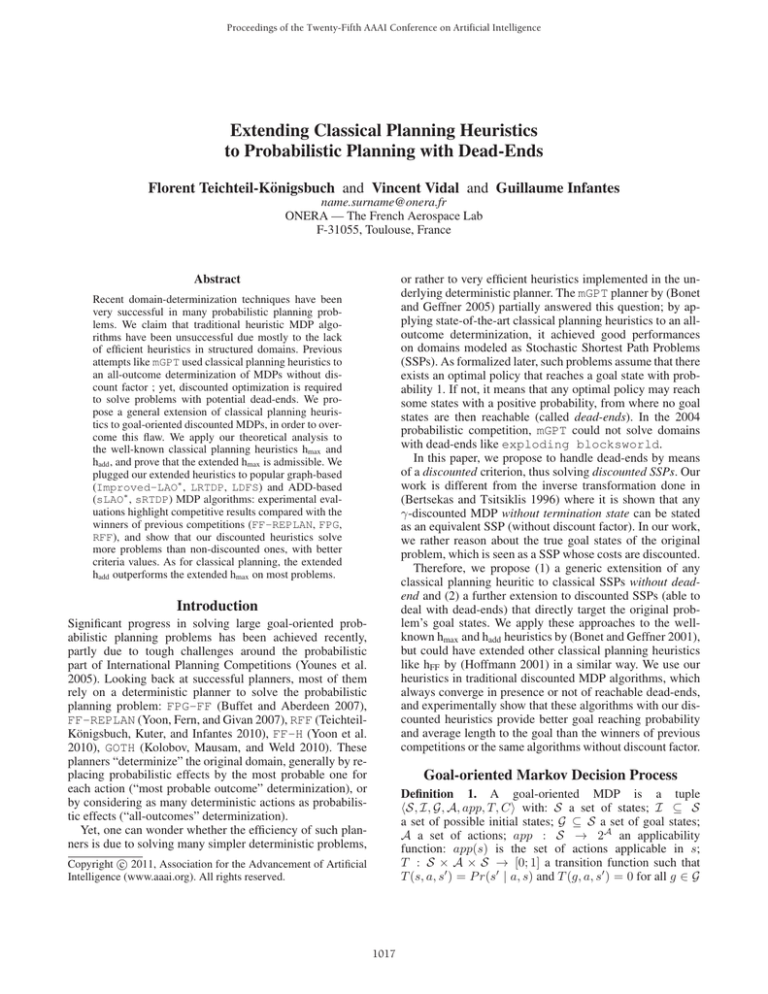
Proceedings of the Twenty-Fifth AAAI Conference on Artificial Intelligence
Extending Classical Planning Heuristics
to Probabilistic Planning with Dead-Ends
Florent Teichteil-Königsbuch and Vincent Vidal and Guillaume Infantes
name.surname@onera.fr
ONERA — The French Aerospace Lab
F-31055, Toulouse, France
or rather to very efficient heuristics implemented in the underlying deterministic planner. The mGPT planner by (Bonet
and Geffner 2005) partially answered this question; by applying state-of-the-art classical planning heuristics to an alloutcome determinization, it achieved good performances
on domains modeled as Stochastic Shortest Path Problems
(SSPs). As formalized later, such problems assume that there
exists an optimal policy that reaches a goal state with probability 1. If not, it means that any optimal policy may reach
some states with a positive probability, from where no goal
states are then reachable (called dead-ends). In the 2004
probabilistic competition, mGPT could not solve domains
with dead-ends like exploding blocksworld.
In this paper, we propose to handle dead-ends by means
of a discounted criterion, thus solving discounted SSPs. Our
work is different from the inverse transformation done in
(Bertsekas and Tsitsiklis 1996) where it is shown that any
γ-discounted MDP without termination state can be stated
as an equivalent SSP (without discount factor). In our work,
we rather reason about the true goal states of the original
problem, which is seen as a SSP whose costs are discounted.
Therefore, we propose (1) a generic extensition of any
classical planning heuritic to classical SSPs without deadend and (2) a further extension to discounted SSPs (able to
deal with dead-ends) that directly target the original problem’s goal states. We apply these approaches to the wellknown hmax and hadd heuristics by (Bonet and Geffner 2001),
but could have extended other classical planning heuristics
like hFF by (Hoffmann 2001) in a similar way. We use our
heuristics in traditional discounted MDP algorithms, which
always converge in presence or not of reachable dead-ends,
and experimentally show that these algorithms with our discounted heuristics provide better goal reaching probability
and average length to the goal than the winners of previous
competitions or the same algorithms without discount factor.
Abstract
Recent domain-determinization techniques have been
very successful in many probabilistic planning problems. We claim that traditional heuristic MDP algorithms have been unsuccessful due mostly to the lack
of efficient heuristics in structured domains. Previous
attempts like mGPT used classical planning heuristics to
an all-outcome determinization of MDPs without discount factor ; yet, discounted optimization is required
to solve problems with potential dead-ends. We propose a general extension of classical planning heuristics to goal-oriented discounted MDPs, in order to overcome this flaw. We apply our theoretical analysis to
the well-known classical planning heuristics hmax and
hadd , and prove that the extended hmax is admissible. We
plugged our extended heuristics to popular graph-based
(Improved-LAO∗ , LRTDP, LDFS) and ADD-based
(sLAO∗ , sRTDP) MDP algorithms: experimental evaluations highlight competitive results compared with the
winners of previous competitions (FF-REPLAN, FPG,
RFF), and show that our discounted heuristics solve
more problems than non-discounted ones, with better
criteria values. As for classical planning, the extended
hadd outperforms the extended hmax on most problems.
Introduction
Significant progress in solving large goal-oriented probabilistic planning problems has been achieved recently,
partly due to tough challenges around the probabilistic
part of International Planning Competitions (Younes et al.
2005). Looking back at successful planners, most of them
rely on a deterministic planner to solve the probabilistic
planning problem: FPG-FF (Buffet and Aberdeen 2007),
FF-REPLAN (Yoon, Fern, and Givan 2007), RFF (TeichteilKönigsbuch, Kuter, and Infantes 2010), FF-H (Yoon et al.
2010), GOTH (Kolobov, Mausam, and Weld 2010). These
planners “determinize” the original domain, generally by replacing probabilistic effects by the most probable one for
each action (“most probable outcome” determinization), or
by considering as many deterministic actions as probabilistic effects (“all-outcomes” determinization).
Yet, one can wonder whether the efficiency of such planners is due to solving many simpler deterministic problems,
Goal-oriented Markov Decision Process
Definition 1. A goal-oriented MDP is a tuple
S, I, G, A, app, T, C with: S a set of states; I ⊆ S
a set of possible initial states; G ⊆ S a set of goal states;
A a set of actions; app : S → 2A an applicability
function: app(s) is the set of actions applicable in s;
T : S × A × S → [0; 1] a transition function such that
T (s, a, s ) = P r(s | a, s) and T (g, a, s ) = 0 for all g ∈ G
c 2011, Association for the Advancement of Artificial
Copyright Intelligence (www.aaai.org). All rights reserved.
1017
where V (s ) = V (s ) if s has already been explored, and
otherwise V (s ) = H(s ), with H : S → R+ . H is a heuristic function that initializes the value of unexplored states. It
is proved (e.g. (Hansen and Zilberstein 2001)), that heuristic algorithms converge to an optimal solution iff H is ad∗
missible, i.e.: ∀s ∈ S, H(s) V π (s). The closer H is to
∗
V π , the less states are explored, and the faster the algorithm
converges. To be efficient in a domain-independent context,
heuristic functions must be much easier to compute than the
value function itself, and as close as possible to the optimal value function. To achieve these antagonist objectives, a
good compromise consists in computing heuristic values on
a relaxed planning domain.
and s ∈ G (goal states are absorbing); C : S × A → R+ a
cost function such that, for all a ∈ A, C(s, a) = 0 if s ∈ G,
and C(s, a) > 0 if s ∈ G.
A solution of a goal-oriented MDP is a partial policy
πX : X ⊆ S → A mapping a subset of states X to actions
minimizing some criterion based on the costs. X contains all
initial states, at least one goal state. Moreover, πX is closed:
states reachable by applying πX on any state in X are in X .
STRIPS representation of MDPs. As formalized in the
PPDDL language (Younes et al. 2005), states can be seen
as collections of atoms from the set Ω of all atoms. Actions
are probabilistic operators of the form o = prec,
mcost, [p1 :
(add1 , del1 ), · · · , pm : (addm , delm )] where i=1 pi = 1
(more details in (Younes et al. 2005; Bonet and Geffner
2005)) and prec is a collection of atoms such that the action is applicable in a state s iff prec ⊆ s; cost is the cost of
the action; for each i ∈ [1; m], pi is the probability of the ith
effect which is represented by the set addi of atoms becoming true and the set deli of atoms becoming false; atoms that
are neither in addi nor in deli keep their values.
New STRIPS relaxation heuristics for SSPs
We here propose a generic extension of classical planning
heuristics to SSPs, by reasoning about the “all-outcome determinization” of the MDP, generalizing the work by (Bonet
and Geffner 2005). We show how to design admissible
heuristics for SSPs from the deterministic case, and apply
our theoretical extension to the hmax and hadd heuristics by
(Bonet and Geffner 2001). Note that we could also have applied our extension to the hFF heuristic (Hoffmann 2001).
As suggested by (Bonet and Geffner 2005), the min-min
admissible heuristic hm-m is recursively defined for every
reachable state s ∈ S \ G by:
Dead-end states. The existence of a solution depends on
structural properties of the goal-oriented MDP, precisely on
the presence of reachable dead-ends, as defined below.
Definition 2. A dead-end is a state from which the probability to reach the goal with any policy is equal to zero.
A non-goal absorbing state is a dead-end state. Now, consider the following criterion, known as the total criterion:
∀s ∈ S, π ∗ (s) = argminπ∈AS E
+∞
t=0
Ct | s0 = s, π
hm-m (s) ←
a∈app(s)
C(s, a) +
min s :T (s,a,s )>0
hm-m (s )
(3)
with the initial conditions: hm-m (s ) = 0 if s ∈ G and
hm-m (s ) = +∞ otherwise. This heuristic counts the minimum number of steps required to reach a goal state in a
non-deterministic relaxation of the domain. The min-min
heuristic is well-informed but it naively searches in the original state space, so that it might explore as many states as
non-heuristic algorithms. But clever heuristics that return a
value lower or equal than hm-m still are admissible.
Let us give the intuition of the STRIPS relaxation heuristics by considering deterministic effects. As states are collections of atoms, only atoms added by successive actions
need to be tracked down. As in (Bonet and Geffner 2001),
we note gs (ω) the cost of achieving an atom ω from a state
s, i.e. the minimum number of steps required from s to have
ω true. This value is computed by a forward chaining procedure where gs (ω) is initially 0 if ω ∈ s and +∞ otherwise:
(1)
where Ct is the cost received at time t starting from s and
executing policy π. If π can reach some dead-end state sd
with a positive probability, as no goal state is reachable from
sd by definition, and because costs received in any non-goal
state are strictly positive, the sum of future costs is +∞.
Thus, eq. 1 has a solution iff there exists at least one policy
that, with probability 1, does not reach any dead-end state.
Unfortunately, deciding if a given domain contains deadends reachable by the optimal policy boils down to optimizing the total criterion itself. Thus, most algorithms based on
this criterion, like mGPT, simply cross the fingers: they try
to solve the problem and hope for the best. Yet, the total
criterion is very popular in heuristic MDP planning because
it allows to design efficient domain-independent admissible
heuristics, as explained in the next section.
gs (ω) ←
Solving undiscounted goal-oriented MDPs
min
a∈A such that:
ω∈add(a)
{gs (ω), cost(a) + gs (prec(a))} (4)
where gs (prec(a)) denotes the cost of achieving the set of
atoms in the preconditions of a. This requires to define the
cost of achieving any set Δ ⊆ Ω of atoms, what can be
computed by aggregating the cost of each atom:
(5)
gs (Δ) = ω∈Δ gs (ω)
This class of MDPs, known as Stochastic Shortest Path
Problems (SSPs) extended to positive costs, has been extensively studied. If there exists an optimal policy reaching
a goal state with probability 1, the total criterion of eq. 1
is well-defined, and heuristic algorithms optimize only relevant states when starting from known initial states, using
the Bellman backup equation (see (Bonet and Geffner 2003;
2006; Hansen and Zilberstein 2001)):
V (s) ← mina∈app(s) C(s, a) + s ∈S T (s, a, s )V (s )
min
When the fixed-point of eq. 4 is reached, the cost of achieving the set of goal states can be computed with eq. 5 and a
heuristic value of s is h⊕ (s) = gs (G). Two aggregation operators have been investigated by (Bonet and Geffner 2001):
(2)
1018
⊕ = max that gives
rise to the hmax heuristic, such that
that provides the hadd heuristic, which
hmax V ∗ ; ⊕ =
is not admissible but often more informative.
Based on this helpful background, we can now extend
hmax and hadd to the total criterion of the probabilistic case.
For proof of admissibility, we are searching for a STRIPS relaxation heuristic whose value is lower than the min-min
relaxation heuristic, as highlighted in the following.
return an infinite value for such state. Thus, because of eq. 2,
the value of any preceding state will be infinite as well; after
some iterations, this infinite value will propagate to at least
one initial state. In fact, this fatal issue arises whatever the
heuristic used: eq. 1 shows that, independently from heuristic values, the value of any dead-end state is equal to +∞.
To cope with the divergence issue of the total criterion,
we extend the previous SSP generalization of classical planning heuristics to discounted SSPs, which, like general MDP
approaches, maximize the following discounted criterion:
Proposition 1. Let M be a goal-oriented MDP without
reachable dead-ends. Let D be a deterministic planning
problem (the “deterministic relaxation of M”), obtained by
replacing each probabilistic effect of each action of M by
a deterministic action having the same precondition and the
add and delete effects of the probabilistic effect. Then, an
admissible heuristic for D is an admissible heuristic for M.
∀s ∈ S, π ∗ (s) = argminπ∈AS E
This proposition means that the hmax heuristic computed
in D is admissible for M. It also demonstrates the admissibility of the heuristics used by mGPT (Bonet and Geffner
2005), but the FF-based one that is not admissible in D.
However, such heuristics require to construct the deterministic relaxation of a goal-oriented MDP before solving it.
To avoid this preliminary construction, we make this deterministic relaxation implicit in a new procedure that directly
computes costs of atoms in the probabilistic domain:
min
a∈A such that:
∃i∈[1;ma ],ω∈addi (a)
t=0
γ t Ct | s0 = s, π
(7)
where 0 < γ < 1 is a discount factor that ensures the convergence of the series of discounted costs for all classes of
MDPs. In particular, values of all dead-ends are now finite
and properly propagate to the initial state in the Bellman
equation. For goal-oriented MDPs, this criterion allows us
to define the following class of problems, that includes SSPs
for γ = 1, and that has always a solution.
Definition 3. A Discounted Stochastic Shortest Path Problem (DSSP) is a goal-oriented MDP whose optimization criterion is given by eq. 7.
+
The generalization of our h+
max and hadd heuristics to the
discounted case relies on the computation of a lower bound
on the minimum non-zero transition cost received along all
paths starting from a state s, by means of a procedure inspired by eq. 6, that also reasons on individual atoms. This
lower bound is required in our approach to handle general
non-unit costs, but it is simply 1 in the unit-costs case. We
compute an admissible heuristic for DSSPs by discounting
successive steps and lowering all transition costs with this
bound. To this purpose, we state and prove the following
theorem, that is valid for general DSSPs.
Theorem 2. Let s be a non-goal state of a DSSP, cs > 0 be
a lower bound on the minimum over all non-zero transition
costs received from s by applying any policy, and ds > 1
a lower bound on the number of steps required to reach a
goal state from s by applying any policy (ds = +∞ if s is
a dead-end). Then, the hγ function defined as follows is an
admissible heuristic:
ds −1 t
γ if ds < +∞
cs t=0
1 − γ ds
γ
= cs
h (s) =
1−γ
otherwise
cs /(1 − γ)
Proof. Let appD be the applicability function for the
deterministic problem. Eq. 3 reduces to hm-m (s) ←
mina∈appD (s) {C(s, a) + hm-m (s )}, which is the update of
optimal costs for D. Let hX be an admissible heuristic for D.
hX is lower than the optimal cost of plans for D, i.e. than the
value of hm-m for M, so it is admissible for M.
gs (ω) ←
+∞
{gs (ω), cost(a)+gs (prec(a))} (6)
Eq. 5 does not need to be changed for the probabilistic case.
As in the deterministic case, we define the new h+
max for SSPs
that is equal to gs (G) with the max aggregation operator.
Theorem 1. The h+
max heuristic is admissible for goaloriented MDPs without reachable dead-ends.
Proof. Let M be a goal-oriented MDP without reachable
dead-ends and D be its deterministic relaxation. Eq. 6 for
M boils down to eq. 4 for D. Thus, h+
max in M has the same
value as hmax in D. Since hmax is admissible for D, and using
proposition 1, hmax and thus h+
max are admissible in M.
+
We also define the new hadd for SSPs as gs (G) with the
+
aggregation operator, but as in the deterministic case, hadd
is not admissible. It is however more informative than h+
max
and, as will be shown in the experiment section for the general discounted case, it is more efficient in practice.
∗
Proof. Let Φπ (s) be the infinite but countable set of execution paths of π ∗ starting in s. Let P (φ) and c(φ) be resp. the
∗
probability and the (accumulated) cost of a path φ ∈ Φπ (s).
Let d(φ) be the length of a path φ until it reaches a goal state
(d(φ) = +∞ if φ does not reach a goal state). By definition of goal-oriented MDPs, all costs received after a goal
is reached are equal to zero. By noting Ctφ the cost received
+∞
at time t along a path φ, we have: c(φ) = t=0 γ t Ctφ =
d(φ)−1 t φ
ds −1 t
γ Ct cs t=0
γ because d(φ) ds and
t=0
∗
P (φ)c(φ) Ctφ cs . Thus: V π (s) =
π∗
φ∈Φ (s)
ds −1 t
ds −1 t
P (φ) cs t=0 γ
= cs t=0 γ because
π∗
φ∈Φ (s)
∗
P
(φ)
=
1.
In
the
special
case ds = +∞ (i.e.
π
φ∈Φ (s)
+∞ t
π∗
s is a dead-end), V (s) cs t=0 γ = cs /(1 − γ).
Discounted Stochastic Shortest Path Problem
+
The previous h+
max and hadd heuristics, as well as heuristics
by (Bonet and Geffner 2005), unfortunately are useless for
goal-oriented MDPs where a policy execution may reach
some dead-end state with a positive probability. As no goal
+
state is reachable from a dead-end, h+
max and hadd may both
1019
if s is not a goal state) and no dead-ends (we can safely set
γ to 1), hγX reduces to h+
X . Finally, we have:
γ
Theorem 3. The hmax heuristic is admissible for all goaloriented MDPs (with or without dead-ends).
Proof. Directly follows from Theorems 1 and 2.
The previous theorem provides a new admissible heuristic
for all discounted goal-oriented MDPs. In the next section,
we will propose atom-space procedures to efficiently compute the lower bounds cs and ds .
New STRIPS relaxation heuristics for DSSPs
To our knowledge, the new hγmax heuristic is an original
atom-space admissible heuristic for all goal-oriented MDPs
with or without dead-ends, whose complexity, like the original hmax , is polynomial in the number of atoms.
Atom-space computation of cs . We can reuse the idea of
the hmax and hadd heuristics, consisting in forgetting delete
effects of the STRIPS domain. We collect all non-zero costs
received by successively applying all applicable actions in
the relaxed domain and keep the minimum one. Let s ∈ S
be a state, ω ∈ Ω be an atom and cs (ω) be the minimum nonzero transition cost received until ω is added, starting from
s. This value is computed by a forward chaining procedure
where cs (ω) is initially 0 if ω ∈ s and +∞ otherwise:
cs (ω) ←
min
a∈A such that:
∃i∈[1;ma ],ω∈addi (a)
cost(a)>0,cs (prec(a))<+∞
cs (ω), cost(a), cs (prec(a))
Experimental evaluations
We tested our approach on 150 problems from the fully observable probabilistic track of the 2008 International Planning Competition (IPC). Each problem was solved by 5
MDP heuristic algorithms (detailed below) with our hγmax
and hγadd heuristics for each of them, and by previous winners of the past IPCs using their last available versions
from their websites and optimized settings (such as ‘alloutcome’ effects for determinization-based planners and
the ATLAS library): FF-REPLAN (Yoon, Fern, and Givan
2007), FPG (Buffet and Aberdeen 2009) and RFF (TeichteilKönigsbuch, Kuter, and Infantes 2010). Each planner was
given at most 10 minutes and 1.8 GB of RAM per problem.
We used the mdpsim simulator from IPCs to evaluate different criteria. As soon as a planner converges or exceeds its
time or memory limits, the simulator executes the planner’s
policy 100 times starting from the problem’s initial state. At
each step of an execution, the simulator samples an outcome
among the effects of the action specified by the planner’s
policy in the current state. Each run stops when a goal state
is reached or after 1000 steps. Each IPC problem was solved
as SSP with unit costs, and three relevant criteria were evaluated: % Goal: percentage of runs where the policy reaches
a goal state; Length (avg): average length of execution runs
that reach a goal state; Time: total time (in seconds) to optimize the policy and execute the runs that reach a goal state.
A problem is considered solved by a planner if its policy
reaches a goal state with a non zero probability.
(8)
where, for all set of atoms Δ ⊆ Ω, cs (Δ) is the minimum
cost received to add all atoms in Δ:
cs (Δ) = minω∈Δ cs (ω)
(9)
When the fixed point of update equation 8 is reached, a lower
bound on the minimum non-zero transition cost received
along all paths starting from a state s is: cm (s) = cs (Ω).
For initialization purposes, we define a filter cs (prec(a)) as
cost(a) if prec(a) ⊆ s and as cs (prec(a)) otherwise.
Atom-space computation of ds . ds can be obtained by
computing the h+
max heuristic on a slight variation of the input domain, where all non-zero costs are set to 1. Indeed, in
such a case, gs (ω) represents the minimum number of steps
required to add the atom ω. Thus, h+
max (s) = maxω∈G gs (ω)
is lower than the minimum number of steps required so that
all atoms in G have been added, what is the intended lower
bound. This simple observation combined with Theorem 2
allows us to derive the admissible heuristic hγmax for DSSPs
from h+
max , the latter being computed by assuming that all
non-zero action costs are equal to 1. We also derive a nonadmissible but well-informed heuristic hγadd from h+
add . We
1,+
+
+
note h1,+
and
h
the
resp.
h
and
h
heuristics
obtained
max
max
add
add
when all non-zero action costs in eq. 6 are replaced by 1.
Definition 4. Let cm (s) be a lower bound on the cost received from a state s by applying any policy as defined
a heuristic with values in N+ such that
above, and h1,+
X
(s)
=
0
if
s
is a goal and h1,+
h1,+
X
X (s) = +∞ if s is a
γ
dead-end. The hX heuristic is defined as:
Candidate MDP heuristic algorithms. We plugged hγmax
and hγadd in several heuristic algorithms: Improved-LAO∗
(Hansen and Zilberstein 2001), LRTDP (Bonet and Geffner
2003), LDFS (Bonet and Geffner 2006), sLAO∗ (Feng and
Hansen 2002), and sRTDP (Feng, Hansen, and Zilberstein
2003). For all planners and problems, the discount factor
was γ = 0.9 and the precision = 0.001.
Experimental results
Comparison with winners of the past IPCs. The first
row of Figure 1 compares all algorithms in the hγmax and
hγadd categories, against all algorithms in the ‘IPC winners’
category. The ‘% goal’ criterion shows that MDP heuristic
algorithms with hγmax or hγadd globally reach the goal with a
higher frequency than overall IPC winners for the problems
which they could solve. Another interesting result is that
exploding blocksworld problems do contain reachable dead-ends, and they are now solved by goal-oriented
MDP heuristic approaches — what was not the case of
1,+
1 − γ hX (s)
hγX (s) = cm (s)
1−γ
1,+
The h1,+
max and hadd both satisfy above conditions, so that
γ
we can define hmax and hγadd . Note that the heuristics of
(Bonet and Geffner 2005), that work only for goal-oriented
MDPs without reachable dead-ends, can be generalized to
the discounted case in the same way, so become helpful in
presence of dead-ends. Moreover, with unit costs (cm (s) = 1
1020
% GOAL
LENGTH (AVG)
100
90
80
70
60
50
40
30
20
10
All IPC winners
All IPC winners
All IPC winners
100
100
10
10
1
0.1
0.01
10
10 20 30 40 50 60 70 80 90 100
100
0.1
All Hmax/Hadd algorithms (γ=0.9)
All Hmax/Hadd algorithms (γ=0.9)
60
40
20
All Hadd algorithms (γ=0.9)
All Hadd algorithms (γ=0.9)
80
1
10
100
All Hmax/Hadd algorithms (γ=0.9)
1000
100
All Hadd algorithms (γ=0.9)
TIME
100
100
10
10
1
0.1
0
100
10
100
All Hmax algorithms (γ=0.9)
100
1000
80
60
40
20
0
0
20
40
60
80
All Hmax/Hadd algorithms (γ=0.9)
100
0.1
1000
All Hmax/Hadd algorithms (γ=1)
20
40
60
80
All Hmax algorithms (γ=0.9)
All Hmax/Hadd algorithms (γ=1)
All Hmax/Hadd algorithms (γ=1)
0
100
10
1
10
100
All Hmax algorithms (γ=0.9)
100
10
1
0.1
0.01
10
100
1000
All Hmax/Hadd algorithms (γ=0.9)
0.1
1
10
100
All Hmax/Hadd algorithms (γ=0.9)
Figure 1: Face-to-face comparisons on problems of IPC 2008. 1st row: all hγ=0.9
and hγ=0.9
algorithms vs. all IPC winners. 2nd
max
add
γ=0.9
γ=0.9
γ=1
γ=0.9
γ=0.9
rd
row: all hmax algorithms vs. all hadd algorithms. 3 row: all hmax and hadd algorithms vs. all hγ=1
max and hadd algorithms.
mGPT (Bonet and Geffner 2005) nor sLAO∗ in the 2004
competition (Younes et al. 2005) — and better than IPC
winners. The same holds for the triangle-tireworld
problems. Moreover, for the problems that could be solved,
the average lengths of hγmax and hγadd algorithms are often comparable to those of IPC winners, except for some
domains where visible differences appear: for instance in
rectangle-tireworld, our heuristics outperform IPC
winners; this is not the case in zenotravel. Finally, as
we expected, IPC winners slightly outperform hγmax or hγadd
algorithms in terms of total time.
than hγadd . Finally, the ‘length’ plot shows that hγadd often
achieves better performance than hγmax for this criterion.
0.9
1
1
h0.9
max /hadd vs. hmax /hadd comparisons. The third row of
Figure 1 compares all MDP heuristic algorithms using the
hγmax and hγadd heuristics with γ = 0.9, against them+
selves with γ = 1 (h+
max and hadd ). The ‘% Goal’ criterion shows that discounted heuristics reach the goal more
frequently than undiscounted ones in most domains except
search-and-rescue, where the 0.9 discount factor is
too small and prevents the planner from seeing the goal, and
triangle-tireworld, where the best among γ = 0.9
and γ = 1 depends on the heuristic used. In all other domains, undiscounted heuristics return an infinite value so
that the final policy is almost random and reaches the goal
with a low probability (a proper policy with γ = 1 outperforms discounted policies). The ‘length’ criterion shows that
discounted heuristics reach the goal with significantly less
steps than undiscounted ones, suggesting that the latter give
rise to almost random policies for most domains. Finally, the
‘time’ criterion clearly points out that discounted heuristics
solve far more problems than undiscounted ones, what highlights the relevance of solving DSSPs as we propose, instead
of SSPs as usual in the literature. Again, the SSP transformation by (Bertsekas and Tsitsiklis 1996) does not apply,
because the goal of the transformed problem does not correspond to actual goals of the original problem.
hγmax vs. hγadd comparisons. The second row of Figure 1 compares all MDP heuristic algorithms using the
hγmax heuristic, against the same algorithms using the
hγadd heuristic. Remind that hγmax is admissible but not
hγadd : yet, strangely enough, the ‘% goal’ criterion plot
shows that hγadd achieves slightly better performances for
this criterion for the exploding blocksworld and
triangle-tireworld domains. The reason is that hγmax
is less informative than hγadd : heuristic algorithms using hγmax
could not converge within the 10 minutes limit for this domain (contrary to the same algorithms using hγadd ), so that
they produced worse suboptimal policies. The ‘time’ criterion plot also confirms that hγmax often consumes more time
resources (including optimization time) to reach the goal
1021
Table 1: Comparisons over all problems of IPC 2008 between algorithms in the three categories: IPC winners, hγmax , and hγadd
(γ = 0.9); subcategories are: IPC winners without RFF, and best of hγmax /hγadd . For each criterion: a bold number indicates the
best element in overall or in its category, a framed number indicates that the overall category is the best for this criterion, and a
symbol indicates the best overall category between hγmax /hγadd and FPG/FF-REPLAN. For columns 3 to 5: the format of cells is
‘a (b) [c]’, where ‘a’ (resp. ‘b’) is the number of problems where the corresponding algorithm is the best among the algorithms
that solved this problem in all categories (resp. its category), and ‘c’ is the average of the criterion among all problems solved.
(Sub)categories are compared among problems that were solved by at least one algorithm in each category.
Algorithm
RFF
FPG
FF-REPLAN
FPG/FF-REPLAN
IPC winners
Improved-LAO∗
LRTDP
LDFS
sLAO∗
sRTDP
Sub. hγmax /hγadd
hγmax /hγadd
# Problems solved
89
44
48
73 100
hγmax
hγadd
55
68
41
50
38
52
32
33
33
36
55
70
72
% Goal
7 (16) [83.22]
6 (11) [83.56]
4 (4) [51.60]
26
43
hγmax
hγadd
7 (24) [91.74] 7 (26) [94.66]
7 (25) [95.14] 7 (26) [94.69]
7 (24) [92.60] 7 (27) [94.78]
7 (24) [93.62] 7 (26) [94.45]
6 (23) [81.18] 7 (27) [78.19]
42 45 46 Detailed comparisons. Table 1 presents more detailed algorithm performances in each category: IPC winners, hγmax
and hγadd . It shows four main results: (1) all MDP heuristic
algorithms achieve comparable performances on all criteria,
meaning that hγmax and hγadd are not really impacted by the encoding of the policy graph nor by the search ordering of the
algorithm; (2) hγadd performs slightly better than hγmax on all
problems (it is not admissible but well-informed); (3) heuristic MDP algorithms using hγmax or hγadd globally achieve better performances than all IPC winners for the ‘% goal’ and
‘length’ criteria; (4) heuristic MDP algorithms using hγmax or
hγadd globally solve as many problems as FF-REPLAN and
FPG, and outperform them on all other criteria.
Length (avg)
4 (13) [76.82]
1 (4) [86.41]
4 (12) [42.50]
15
26
hγmax
hγadd
1 (12) [29.11] 2 (14) [26.21]
1 (10) [13.49] 1 (13) [16.95]
1 (11) [20.97] 1 (11) [19.18]
2 (10) [15.28] 1 (13) [14.48]
1 (3) [13.41]
2 (7) [14.70]
23 24 35 Time
4 (9) [13.20]
0 (0) [44.10]
0 (10) [20.34]
10
30
hγmax
hγadd
0 (15) [20.04] 2 (9) [36.50]
0 (1) [24.58]
0 (4) [29.69]
1 (4) [26.83]
1 (7) [14.45]
0 (1) [72.46]
0 (0) [40.28]
0 (1) [102.59] 0 (0) [88.71]
9
11 19 Bonet, B., and Geffner, H. 2001. Planning as heuristic search. AIJ
129(1-2):5–33.
Bonet, B., and Geffner, H. 2003. Labeled RTDP: Improving the
convergence of real-time dynamic programming. In Proc. ICAPS.
Bonet, B., and Geffner, H. 2005. mGPT: A probabilistic planner
based on heuristic search. JAIR 24:933–944.
Bonet, B., and Geffner, H. 2006. Learning depth-first search:
A unified approach to heuristic search in deterministic and nondeterministic settings, and its application to mdps. In Proc. ICAPS.
Buffet, O., and Aberdeen, D. 2007. FF+FPG: Guiding a policygradient planner. In Proc. ICAPS, 42–48.
Buffet, O., and Aberdeen, D. 2009. The factored policy-gradient
planner. Artificial Intelligence 173(5-6):722–747.
Feng, Z., and Hansen, E. A. 2002. Symbolic heuristic search for
factored markov decision processes. In Proc. AAAI, 455–460.
Feng, Z.; Hansen, E. A.; and Zilberstein, S. 2003. Symbolic generalization for on-line planning. In Proc. UAI, 209–216.
Hansen, E. A., and Zilberstein, S. 2001. LAO* : A heuristic search
Conclusion
We provide new atom-space heuristics for probabilistic planning with dead-ends generalized from efficient classical
planning heuristics: hγmax , for which we prove its admissibility, and hγadd , which is not admissible but often more informative than the former. These heuristics allow MDP heuristic
algorithms to work in presence (or not) of dead-ends, i.e.
when all possible policies reach with a positive probability a state from where no goal state can be achieved. Experimental results show that implementing efficient atomspace heuristics at the core of MDP heuristic algorithms
rather than in an underlying deterministic planner, achieves
nearly competitive performances with winners of past international planning competitions in terms of number of problems solved and computation time, while providing better
goal reaching probability and average length to the goal.
algorithm that finds solutions with loops. AIJ 129(1-2):35–62.
Hoffmann, J. 2001. FF: The fast-forward planning system. AI
Magazine 22(3):57–62.
Kolobov, A.; Mausam; and Weld, D. S. 2010. Classical planning
in MDP heuristics: With a little help from generalization. In Proc.
ICAPS, 97–104.
Teichteil-Königsbuch, F.; Kuter, U.; and Infantes, G. 2010. Incremental plan aggregation for generating policies in MDPs. In Proc.
AAMAS, 1231–1238.
Yoon, S. W.; Ruml, W.; Benton, J.; and Do, M. B. 2010. Improving
determinization in hindsight for on-line probabilistic planning. In
Proc. ICAPS, 209–217.
Yoon, S.; Fern, A.; and Givan, R. 2007. FF-Replan: A baseline for
probabilistic planning. In Proc. ICAPS, 352–359.
Younes, H. L. S.; Littman, M. L.; Weissman, D.; and Asmuth, J.
2005. The first probabilistic track of the International Planning
Competition. JAIR 24:851–887.
References
Bertsekas, D. P., and Tsitsiklis, J. N. 1996. Neuro-Dynamic Programming. Athena Scientific.
1022

